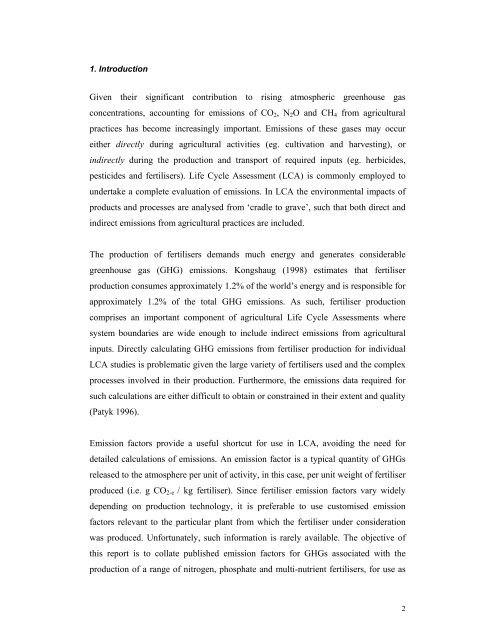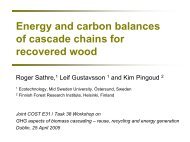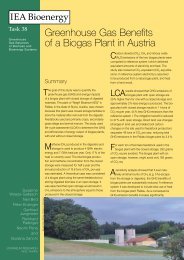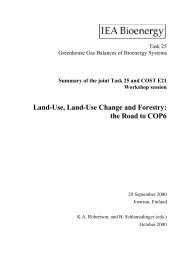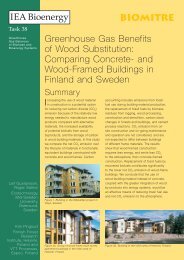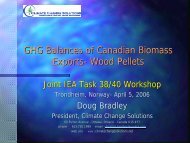A review of greenhouse gas emission factors for fertiliser production.
A review of greenhouse gas emission factors for fertiliser production.
A review of greenhouse gas emission factors for fertiliser production.
Create successful ePaper yourself
Turn your PDF publications into a flip-book with our unique Google optimized e-Paper software.
1. IntroductionGiven their significant contribution to rising atmospheric <strong>greenhouse</strong> <strong>gas</strong>concentrations, accounting <strong>for</strong> <strong>emission</strong>s <strong>of</strong> CO 2 , N 2 O and CH 4 from agriculturalpractices has become increasingly important. Emissions <strong>of</strong> these <strong>gas</strong>es may occureither directly during agricultural activities (eg. cultivation and harvesting), orindirectly during the <strong>production</strong> and transport <strong>of</strong> required inputs (eg. herbicides,pesticides and <strong>fertiliser</strong>s). Life Cycle Assessment (LCA) is commonly employed toundertake a complete evaluation <strong>of</strong> <strong>emission</strong>s. In LCA the environmental impacts <strong>of</strong>products and processes are analysed from ‘cradle to grave’, such that both direct andindirect <strong>emission</strong>s from agricultural practices are included.The <strong>production</strong> <strong>of</strong> <strong>fertiliser</strong>s demands much energy and generates considerable<strong>greenhouse</strong> <strong>gas</strong> (GHG) <strong>emission</strong>s. Kongshaug (1998) estimates that <strong>fertiliser</strong><strong>production</strong> consumes approximately 1.2% <strong>of</strong> the world’s energy and is responsible <strong>for</strong>approximately 1.2% <strong>of</strong> the total GHG <strong>emission</strong>s. As such, <strong>fertiliser</strong> <strong>production</strong>comprises an important component <strong>of</strong> agricultural Life Cycle Assessments wheresystem boundaries are wide enough to include indirect <strong>emission</strong>s from agriculturalinputs. Directly calculating GHG <strong>emission</strong>s from <strong>fertiliser</strong> <strong>production</strong> <strong>for</strong> individualLCA studies is problematic given the large variety <strong>of</strong> <strong>fertiliser</strong>s used and the complexprocesses involved in their <strong>production</strong>. Furthermore, the <strong>emission</strong>s data required <strong>for</strong>such calculations are either difficult to obtain or constrained in their extent and quality(Patyk 1996).Emission <strong>factors</strong> provide a useful shortcut <strong>for</strong> use in LCA, avoiding the need <strong>for</strong>detailed calculations <strong>of</strong> <strong>emission</strong>s. An <strong>emission</strong> factor is a typical quantity <strong>of</strong> GHGsreleased to the atmosphere per unit <strong>of</strong> activity, in this case, per unit weight <strong>of</strong> <strong>fertiliser</strong>produced (i.e. g CO 2-e / kg <strong>fertiliser</strong>). Since <strong>fertiliser</strong> <strong>emission</strong> <strong>factors</strong> vary widelydepending on <strong>production</strong> technology, it is preferable to use customised <strong>emission</strong><strong>factors</strong> relevant to the particular plant from which the <strong>fertiliser</strong> under considerationwas produced. Un<strong>for</strong>tunately, such in<strong>for</strong>mation is rarely available. The objective <strong>of</strong>this report is to collate published <strong>emission</strong> <strong>factors</strong> <strong>for</strong> GHGs associated with the<strong>production</strong> <strong>of</strong> a range <strong>of</strong> nitrogen, phosphate and multi-nutrient <strong>fertiliser</strong>s, <strong>for</strong> use as2


